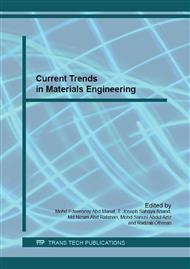[1]
S.R. Teixeira, A.E. Souza, C.L. Carvalho, V.C.S. Reynoso, M. Romero, J. Ma, Characterization of a wollastonite glass-ceramic material prepared using sugar cane bagasse ash (SCBA) as one of the raw materials, Mater. Charact. 98 (2014) 209-214.
DOI: 10.1016/j.matchar.2014.11.003
Google Scholar
[2]
R.A. Rashid, R. Shamsudin, M.A.A. Hamid, A. Jalar, In-vitro bioactivity of wollastonite materials derived from limestone and silica sand, Ceram. Int. 40 (2014) 6847-6853.
DOI: 10.1016/j.ceramint.2013.12.004
Google Scholar
[3]
M.M. Shukur, E.A. Al-Majeed, M.M. Obied, Characteristic of wollastonite synthesized from local raw materials. Int. J. Eng. Technol. 4(7) (2014).
Google Scholar
[4]
E. Tasci, The Use of Synthetic Wollastonite in Wall Tile Glazes, J. Aust. Ceram. Soc. 50 (2014) 43-51.
Google Scholar
[5]
Y.H. Yun, S.B. Kim, B.A. Kang, Y.W. Lee, J.S. Oh, K.S. Hwang, β-Wollastonite Reinforced Glass-Ceramics Prepared From Waste Fluorescent Glass and Calcium Carbonate, J. Mater. Process. Technol. 178 (2006) 61-66.
DOI: 10.1016/j.jmatprotec.2005.11.021
Google Scholar
[6]
J.R. Jones, L.L. Hench, Regeneration of trabecular bone using porous ceramics, Curr. Opin. Solid State Mater. Sci. 7 (2003) 301-307.
DOI: 10.1016/j.cossms.2003.09.012
Google Scholar
[7]
S. Deville, Freeze-casting of porous biomaterials: Structure, properties and opportunities, Materials 3 (2010) 1913-(1927).
DOI: 10.3390/ma3031913
Google Scholar
[8]
W.F. Wolkers, J.M. Walker, Cryopreservation and Freeze-Drying Protocols, third ed., Springer, UK, (2015).
Google Scholar
[9]
R. Morsy, R. Abuelkhair, T. Elnimr, Synthesis of microcrystalline wollastonite bioceramics and evolution of bioactivity, Silicon (2014) 1-5.
DOI: 10.1007/s12633-014-9243-x
Google Scholar
[10]
L.Z. Pei, L.J. Yang, Y. Yang, C.G. Fan, W.Y. Yin, J. Chen, Q.F. Zhang, A green and facile route to synthesize calcium silicate nanowires, Mater. Charact. 61 (2010) 1281-1285.
DOI: 10.1016/j.matchar.2010.07.002
Google Scholar
[11]
T. Kokubo, H. Takadama, How useful is SBF in predicting in vivo bone bioactivity?, Biomaterials 27 (2006) 2907-2915.
DOI: 10.1016/j.biomaterials.2006.01.017
Google Scholar
[12]
E. F. Nordstrand, A. N. Dibbs, A. J. Eraker, U. J. Gibson, Alkaline oxide interface modifiers for silicon fiber production, Opt. Mater. Express 3 (2013) 651-656.
DOI: 10.1364/ome.3.000651
Google Scholar
[13]
X. Liu, C. Ding, Morphology of apatite formed on surface of wollastonite coating soaked in simulate body fluid, Mater. Lett. 57 (2002) 652-655.
DOI: 10.1016/s0167-577x(02)00848-0
Google Scholar
[14]
X. Liu, C. Ding, P.K. Chu, Mechanism of apatite formation on wollastonite coatings in simulated body fluids, Biomaterials 25 (2004) 1755–1761.
DOI: 10.1016/j.biomaterials.2003.08.024
Google Scholar
[15]
M. Mami, A. Lucas-Girot, H. Oudadesse, R. Dorbez-Sridi, F. Mezahi, E. Dietrich, Investigation of the surface reactivity of a sol-gel derived glass in the ternary system SiO2-CaO-P2O5, Appl. Surf. Sci. 254 (2008) 7386-7393.
DOI: 10.1016/j.apsusc.2008.05.340
Google Scholar
[16]
M. Mozafari, F. Moztarzadeh, M. Tahriri, Investigation of the physico-chemical reactivity of a mesoporous bioactive SiO2-CaO-P2O5 glass in simulated body fluid, J. Non. Cryst. Solids 356 (2010) 1470-1478.
DOI: 10.1016/j.jnoncrysol.2010.04.040
Google Scholar
[17]
Y. Li, W. Weng, In vitro synthesis and characterization of amorphous calcium phosphates with various Ca/P atomic ratios, J. Mater. Sci. Mater. Med. 18 (2007) 2303-2308.
DOI: 10.1007/s10856-007-3132-4
Google Scholar
[18]
S.V. Dorozhkin, Amorphous calcium (ortho)phosphates, Acta Biomater. 6 (2010) 4457-4475.
DOI: 10.1016/j.actbio.2010.06.031
Google Scholar
[19]
S. Jebahi, H. Oudadesse, E. Wers, J. Elleuch, H. Elfekih, H. Keskes, X. Vuong, Effect of pH and ionic exchange on the reactivity of bioglass/chitosan composites used as a bone graft substitute, Int. J. Chem. Mol. Nucl. Mater. Metall. Eng. 7 (2013).
Google Scholar


